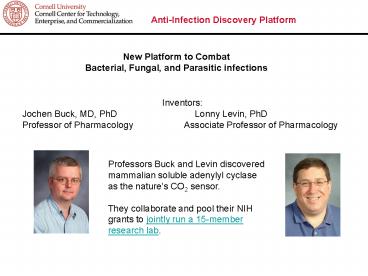Anti-Infection Discovery Platform - PowerPoint PPT Presentation
1 / 7
Title:
Anti-Infection Discovery Platform
Description:
Professor of Pharmacology Associate Professor of Pharmacology ... They collaborate and pool their NIH grants to jointly run a 15-member research lab. ... – PowerPoint PPT presentation
Number of Views:46
Avg rating:3.0/5.0
Title: Anti-Infection Discovery Platform
1
Anti-Infection Discovery Platform
New Platform to Combat Bacterial, Fungal, and
Parasitic infections
Inventors Jochen Buck, MD, PhD Lonny
Levin, PhD Professor of Pharmacology
Associate Professor of Pharmacology
Professors Buck and Levin discovered mammalian
soluble adenylyl cyclase as the natures CO2
sensor. They collaborate and pool their NIH
grants to jointly run a 15-member research lab.
2
Anti-Infection Discovery Platform
Market
Bacterial infection 20B Fungal
infection 2B Malaria 500M Applications
may encompass both human and veterinarian space.
3
Anti-Infection Discovery Platform
Prior to 1999 Adenylyl cyclase (AC) generates
cyclic AMP ubiquitous second messenger system
conserved from bacteria to man Mammals had
transmembrane AC simpler life forms have soluble
AC as well In 1999 Cornell inventors discovered
mammalian soluble AC (sAC), and found that it is
CO2 responsive functions as a key metabolic
sensor. More recently, inventors studied CO2
responsiveness of sAC from microbes found same
paradigm
4
Anti-Infection Discovery Platform
CO2 concentration is more than 150-fold higher
(5) inside mammals than in air (0.033).
Pathogenic microbes use CO2-sensing sAC to
determine if they are in air or in a host. In a
host, pathogenic processes are set off, including
morphological changes, advances through life
cycle, and toxin secretion.
E. Coli. Lane 3 is 5 CO2 P80 is Tir, a
secreted toxin
Plasmodium maturation in red blood cells
requires high CO2
C. albicans filamentation
5
Anti-Infection Discovery Platform
Current Anti-infection Paradigm
New Paradigm
Normal bugs Pathogenic bugs Normal
bugs remain alive.
Pathogenic Process
Drug Treatment
Inhibiting CO2-sensing sAC generally blocks
pathogenesis but not necessarily killing the
microbes. Does not harm normal flora and may
decrease tendency for resistance to evolve.
6
- Technology Status
- Validated concept in Candida albicans with
knockout - Cloned relevant CO2-sensing sAC from C. albicans,
an opportunistic pathogen in human, and used for
screening - Cloned relevant CO2-sensing sAC from Pseudomonas
aeruginosa, an opportunistic human and plant
pathogen, and used for screening - Established HTS screen for sAC inhibitors, with
counterscreen against human sAC - Identified nonproprietary, microbe-selective hits
(3rd generation library) - Tested hits against Plasmodium falciparum, an
obligatory parasite that causes malaria,
cultivated in human red blood cells killed them - Tested hits against live Trypanosoma brucei, an
obligatory protist that causes sleeping disease
prevented growth - Cloning of CO2-sensing sAC from other pathogens
for HTS underway at Cornell
7
- Intellectual Property
- Issued US Patent on mammalian sAC for
counterscreen (US6544768) - Applications pending in US, EP, China, and India
for malaria and fungal infection (nationalized
PCT WO2005070419 note published apps do not
reflect preliminary amendments) - Provisional applications filed for broad uses of
platform - Publications
- Mogensen EG, et al. (2006) Cryptococcus
neoformans senses CO2 through the carbonic
anhydrase Can2 and the adenylyl cyclase Cac1.
Eukaryot Cell. 5(1)103-11. - Klengel T, et al (2005) Fungal adenylyl cyclase
integrates CO2 sensing with cAMP signaling and
virulence. Curr Biol. 15(22)2021-6. - Bank et al, (Submitted) Killing malaria parasites
by inhibiting the Plasmodium falciparum carbon
dioxide sensor.































